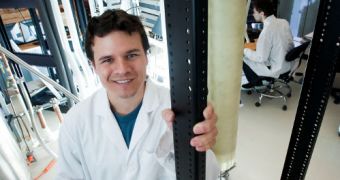Massachusetts Institute of Technology (MIT) investigators determined in a new study that graphene is capable of displaying very interesting thermoelectric reactions when exposed to light. The new behavior has not been studied before, but experts say that it could have many practical applications.
Graphene is a bi-dimensional material made up of carbon atoms arranged in a hexagonal matrix. It displays countless interesting chemical and physical properties, such as being an excellent conductor, as well as the strongest material in the world.
Experts say that the carbon compound could easily replace silicon in all electronic devices within a few years, as soon as the techniques necessary to give it a band gap are developed in a manner applicable at a large scale.
In the mean time, scientists continue to discover more and more interesting properties, which further boost the potential applications the material already has. With data collected in the new study, it may become possible to use graphene to create advanced photodetectors and night-vision systems.
In their studies of graphene, the MIT team created sheets of the material that had different electric properties on either side. When a light was shone on these sheets, the team observed that the material was heated up at different temperatures.
The difference between these temperatures triggered the release of electric current, in a mechanism the investigators named a hot carrier response. MIT scientist Pablo Jarillo-Herrero says that this type of reaction to light “is very unusual.”
The MIT assistant physics professor was also the senior author of a new paper describing the findings, which is published in the latest print issue of the top journal Science. Postdoctoral researcher Nathaniel Gabor was the lead author of the paper.
Four MIT students, physics professor Leonid Levitov and two Japanese scientists from the National Institute for Materials Science, in Tsukuba, were the coauthors of the Science investigation. Together, the scientists observed that the graphene matrix did not heat up, even when the electrons did.
Such an effect has thus far been observed only in materials cooled down very close to absolute zero, or in compounds that were blasted with high-energy lasers. In graphene, the unusual response is triggered even by sunlight at room temperature.
The MIT group and its collaborators now plan to conduct additional investigations into this hot carrier response, with the goal of harnessing its capabilities for practical applications.

 14 DAY TRIAL //
14 DAY TRIAL //